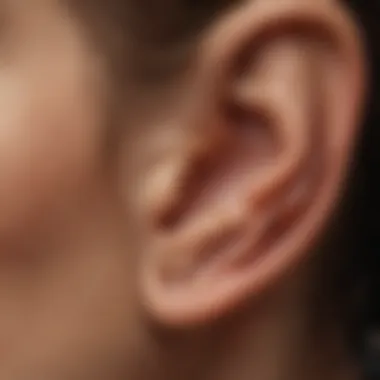Understanding Noise Stoppers: Benefits & Applications


Intro
In contemporary society, understanding how to protect our auditory senses is becoming increasingly important. Noise stoppers for ears serve specific functions in various settings, significantly contributing to hearing conservation. With noises ranging from urban environments to occupational hazards, these devices play an essential role in safeguarding our auditory health. This article will delve into the diverse types of noise stoppers available, their applications, and the benefits they provide.
Understanding Noise Stoppers
Noise stoppers are devices designed to reduce sound exposure. They are crucial for maintaining auditory health in loud environments. Individuals who are frequently exposed to high decibels, such as musicians or construction workers, can greatly benefit from using these products. They not only help in sound attenuation but also in providing comfort.
Types of Noise Stoppers
- Earplugs: These simple devices are made from foam, silicone, or wax. They fit snugly into the ear canal, blocking external sounds efficiently.
- Earmuffs: Earmuffs cover the entire outer ear. They are often used in industrial settings and can be more effective for those who may find earplugs uncomfortable.
- Electronic Noise Canceling Devices: These advanced tools actively counteract sound waves. They are useful in both personal and professional industries, as they can adapt to different noise levels.
"Proper use of noise stoppers can preserve your hearing for years to come."
Effectiveness and Design Features
The effectiveness of noise stoppers varies based on their design and intended use. Many earplugs have a Noise Reduction Rating (NRR) indicating how much sound they can block. It is essential to choose products that suit specific environments. Well-designed noise stoppers also consider comfort and usability, ensuring that wearers can use them for extended periods without discomfort.
Applications of Noise Stoppers
Noise stoppers can be applied in various scenarios:
- Workplace Safety: Many industries require hearing protection. Noise stoppers allow workers to perform their tasks safely.
- Musical Environments: Musicians often use earplugs to guard against hearing damage while still allowing them to hear their music.
- Leisure Activities: While attending concerts or sports events, noise stoppers can enhance the experience while protecting hearing.
Considerations for Users
Before selecting noise stoppers, individuals should evaluate their specific needs. Factors such as the environment, comfort, and sound isolation level must be considered. Some may need reusable options, while others might prefer disposable products. Understanding one’s personal requirements is essential to successfully protect hearing.
Ending
In summary, noise stoppers for ears are vital for individuals exposed to loud environments. Their various types, effectiveness, applications, and considerations underscore the importance of auditory protection. By choosing the right noise stopper for specific needs, individuals can effectively safeguard their hearing health.
Intro to Noise Stoppers for Ears
Noise stoppers, commonly known as earplugs or hearing protectors, hold significant relevance in today's increasingly noisy environment. The necessity for auditory protection has grown, owing to the prevalence of both industrial noise and everyday disturbances. Understanding noise stoppers is crucial, as these devices serve as a barrier to unwanted sounds, promoting not only comfort but also overall health. Their applications span multiple sectors, enriching the work-life quality of individuals while safeguarding auditory health.
Choosing the right noise stopper can significantly impact personal well-being. Whether in a busy urban setting, at live concerts, or within industrial spaces, the right choice can enhance productivity and reduce stress. Therefore, exploring various types of noise stoppers and their benefits equips readers with knowledge crucial for informed decisions regarding auditory protection.
The Definition of Noise Stoppers
Noise stoppers are devices designed to reduce or eliminate unwanted ambient sounds, typically used in the ears. They come in various formats, such as earplugs, earmuffs, and electronic noise-canceling devices. Their primary function is to diminish sound intensity before it reaches the inner ear, where sensitive structures can incur damage from excessive noise exposure. The effectiveness of a noise stopper often depends on its design, material, and intended use, with some products offering passive noise reduction while others incorporate advanced technology.
Historical Background of Ear Protection
The evolution of ear protection is a fascinating journey through time. Earplugs have a longstanding history, dating back to ancient civilizations. In ancient Rome, we find references to the use of ear furs for soldiers to shield them from battle noise. As industries began to grow during the Industrial Revolution, increased noise levels prompted a more structured approach to hearing protection. The early 20th century saw the introduction of foam earplugs, made from materials like cotton and wax, perceived as rudimentary but innovative for their time.
The latter part of the 20th century witnessed significant advancements in earplug technology. Companies like Moldex and Howard Leight pioneered the production of high-performance earplugs specifically tailored for various industrial settings. Today, custom-molded earplugs and advanced electronic devices have transformed the landscape of noise protection, catering to diverse needs in both professional and personal environments. The continued evolution highlights the growing understanding of noise-induced hearing loss, emphasizing the importance of adequate ear protection.
Types of Noise Stoppers
Understanding the types of noise stoppers available is pivotal for individuals seeking effective auditory protection. Each type offers unique benefits and considerations, allowing users to tailor their choices to specific environments or personal comfort levels. The right selection can significantly influence the effectiveness of noise reduction, ultimately impacting long-term hearing health and overall quality of life.
Foam Ear Plugs
Foam ear plugs are among the most widely utilized noise stoppers. Made from soft foam that expands to fit the ear canal, they are designed for maximum comfort and convenience. This type of ear plug is inexpensive and readily available, making them popular for casual users.
Benefits of foam ear plugs include:
- Cost-effective: Very affordable compared to other options.
- Disposability: Often disposable, leading to easy maintenance.
- Wide availability: Can be found in many retail and online stores.
Though they are effective at reducing noise, their fit can vary. It's important to ensure proper insertion to achieve the desired noise reduction. For people who encounter difficulty with the insertion or discomfort after extended use, alternative options might be necessary.


Silicone Ear Plugs
Silicone ear plugs provide a more customizable fit than their foam counterparts. They come in various shapes and sizes, including reusable variations, which makes them both practical and eco-friendly. They can be shaped to snugly fit an ear, providing a reliable seal against unwanted sounds.
Characteristics of silicone ear plugs include:
- Reusable: Many are washable and designed for repeated use.
- Comfortable: Generally softer and more malleable.
- Water-resistant: Some types also prevent water entry, beneficial for swimming or other aquatic activities.
These plugs are frequently favored by swimmers and individuals looking for noise protection in water-related situations. Yet, when it comes to loud environments, silicone might not seal as tightly, so testing them in different situations is wise.
Custom-Molded Ear Plugs
For those who prioritize a precise fit, custom-molded ear plugs offer an unparalleled solution. These devices are made from an impression of the user’s ear canal, resulting in a product tailored specifically to their anatomy. As a result, they provide excellent noise isolation.
Advantages of custom-molded plugs are as follows:
- Best fit: Tailored to the unique shape of the ear canal, enhancing the seal.
- Comfortable for long wear: Ideal for people needing all-day protection, such as musicians.
- Variety of designs: Available for different uses, including noise reduction and water prevention.
Due to their high level of customization, they may come with a higher price point. Yet, the investment can be justified by the comfort and effectiveness they offer.
Electronic Noise Canceling Devices
Electronic noise-canceling devices employ advanced technology to significantly reduce ambient sounds. This type of device has microphones that pick up external noise and produce sound waves that cancel out unwanted sound frequencies.
Key features of electronic noise canceling devices include:
- Active noise cancellation: Provides a substantial reduction in persistent sounds, like engines or machinery.
- Versatility: Suitable for various environments, including travel and work.
- Comfortable: Often designed for long-term wear.
However, these devices usually require batteries or charging, which adds a layer of maintenance not present with passive options. Users need to be aware of this aspect when considering their use.
Noise-Canceling Headphones
Noise-canceling headphones are another popular choice for auditory protection. They feature similar technology to electronic noise-canceling devices but are integrated into headphone design. This function is especially beneficial for people who want to enjoy music while minimizing background noise.
Benefits of noise-canceling headphones include:
- Sound quality: Many models also provide high-fidelity audio output.
- Extended wear: Designed for comfort, allowing long listening sessions.
- Mobility: Portable and often wireless, making them suitable for different environments.
However, they might not offer the same level of noise isolation as custom-molded devices. Understanding this distinction can guide users in choosing more appropriate options based on their needs.
"Selecting the right type of noise stopper is crucial for optimizing sound protection, comfort, and effectiveness."
Overall, understanding the variance among these types can be beneficial in choosing the best tools for protecting one’s hearing effectively.
Mechanisms of Noise Reduction
Understanding the mechanisms behind noise reduction is crucial when evaluating the effectiveness of noise stoppers for ears. These mechanisms inform users about how different devices manage sound, providing insights into their appropriate application and benefits. In a world increasingly filled with auditory distractions, knowing the right noise reduction techniques can considerably enhance both hearing protection and overall quality of life.
Passive Noise Reduction Techniques
Passive noise reduction techniques utilize materials that obstruct sound waves. These methods rely on the physical blocking of noise rather than electronic means. Common materials for passive noise reduction include foam, silicone, and rubber. For example, foam ear plugs are widely popular due to their ability to conform to the shape of the ear canal, creating an effective seal that significantly reduces noise levels.
Some notable features of passive noise reduction techniques include:
- Simple Design: Most passive devices are straightforward in design, making them user-friendly.
- No Battery Required: Unlike active devices, passive noise stoppers do not need power sources for operation.
- Affordability: They are often more cost-effective compared to advanced electronic options.
However, it is essential to note that passive techniques may not be suitable for all situations. Their effectiveness relies on ambient sound levels and the fit of the device. If the earplugs do not fit securely, sound leakage can occur, limiting their efficacy. Furthermore, while they are useful in moderately noisy environments, they might not completely attenuate louder sounds where hearing protection is critical.
Active Noise Cancellation Technology
Active noise cancellation (ANC) employs sophisticated technology to counteract unwanted sounds. This method involves using microphones to pick up surrounding noise and generating sound waves that are the exact opposite (phase-inverted) of those noises. When these waves meet, they effectively cancel each other out.


Active noise cancellation provides several advantages:
- Effective in Dynamic Environments: ANC is particularly beneficial in high-noise situations like airplanes, trains, or crowded urban areas.
- Comfort: Many ANC headphones are designed to be worn for extended periods without discomfort, marking them as ideal for travel or busy work environments.
- Enhanced Auditory Experience: Users can listen to music or conversations more clearly without raising the volume excessively.
Nonetheless, active systems come with some considerations. They usually require power sources, are typically more expensive, and may not perform optimally with constant or sharp sounds, such as talking or sudden noises. For optimal performance, ANC should be used in conjunction with passive noise cancellation when appropriate.
"Combining passive and active techniques can yield the best results for noise management."
Applications of Noise Stoppers
Noise stoppers serve essential purposes across various environments. Understanding their applications is critical, as it helps to recognize the diverse benefits they can offer. This section highlights different settings where noise stoppers prove valuable, considering both practical implementations and their repercussions on the users' auditory experiences.
In Industrial Settings
In industrial environments, noise stoppers are crucial for protecting workers' hearing from excessive sounds. Many workplaces, such as factories and construction sites, frequently expose employees to harmful noise levels. Prolonged exposure to such environments can lead to irreversible hearing loss.
Implementing noise stoppers like earmuffs and earplugs helps mitigate sound levels. Many industries adopt this equipment as part of their health and safety standards. Furthermore, companies often conduct training sessions to emphasize the importance of auditory protection among employees.
For Musicians and Performers
Musicians and performers frequently encounter high noise levels, whether in crowded venues or during rehearsals. Noise stoppers tailored for this demographic help balance sound quality while preserving hearing. By using customized earplugs or electronic noise-canceling devices, they can reduce background noise without diminishing the music experience.
These noise stoppers enable artists to focus better on their performance without compromising their auditory health. It is common for music schools to educate students about the risks of noise exposure and the importance of using hearing protection.
Personal Use for Everyday Noise Management
For individuals seeking to manage daily noise—from traffic to construction work—noise stoppers provide a practical solution. Foam earplugs and noise-canceling headphones are commonly used in these situations. Everyday life often includes unwanted disturbances, which can hinder concentration and relaxation.
By utilizing noise stoppers, people can create a more serene atmosphere in their homes or during commutes. This strategy aids focus and enhances sleep quality, contributing to a healthier lifestyle.
Use in Medical Environments
Medical settings also benefit from noise stoppers, particularly during procedures that require patient concentration and tranquility. For instance, practices like audiology utilize sound-dampening devices to reduce intricate noises that could lead to patient discomfort.
In a hospital, staff might wear noise-canceling headphones during sleep studies to ensure a controlled environment for patients. The advantages of these applications extend to both healthcare professionals and patients who require a peaceful atmosphere for optimal recovery.
Protecting the hearing of individuals in diverse environments ensures a better quality of life for everyone.
In summary, the applications of noise stoppers are varied and essential across multiple sectors. These devices not only protect hearing but also enhance overall experiences in professional, artistic, personal, and medical contexts.
Benefits of Using Noise Stoppers
Noise stoppers are pivotal for maintaining hearing health and enhancing quality of life. The diverse range of applications speaks not just to their versatility but also to their efficacy in several conditions. Each benefit interplays with unique aspects of daily routines and occupational risks, underscoring the necessity of adopting these devices.
Hearing Loss Prevention
Hearing loss is a gradual process often unnoticed until it has progressed significantly. Frequent exposure to loud environments, especially in industries like construction or manufacturing, can lead to irreversible damage. Noise stoppers offer a preventive measure against this deterioration of auditory function. They work by substantially reducing sound levels that reach the inner ear, therefore protecting delicate hair cells in the cochlea from excessive noise. It is essential for workers in high-decibel settings to use appropriate noise stoppers, as even short bursts of loud noise can be harmful. Regularly using ear protection such as foam ear plugs or custom-molded devices mitigates the risk of developing noise-induced hearing loss over time.
Improved Sleep Quality
Noise can disturb sleep, leading to tiredness and cognitive impairment during the day. Many individuals living in urban environments face disruptions from traffic, construction, or neighbors. Noise stoppers can effectively block these disturbances, allowing a more restful sleep experience. Research indicates that reducing noise while sleeping enhances overall sleep quality and can lead to better health outcomes. Sleep is critical for recovery and cognitive function, making it vital that individuals consider using noise stoppers—especially those designed for sleep. Good options may include silicone ear plugs or special sleep masks with sound dampening features.
Enhanced Concentration and Productivity
In work environments where focus is paramount, unwanted noise can be a significant barrier. The presence of distracting sounds can hinder concentration, leading to decreased productivity. Noise stoppers facilitate a quieter atmosphere, enabling individuals to concentrate better on tasks at hand. For example, electronic noise-canceling devices can create a controlled environment by filtering out background sounds effectively. This is particularly advantageous for professionals working in open offices or study environments. Improved focus not only boosts individual performance but can also foster better teamwork and communication among colleagues, as distractions are minimized.
"The use of noise stoppers can enhance productivity while simultaneously safeguarding one’s hearing and overall well-being."
The benefits of using noise stoppers are evident across various domains. From protecting against hearing loss to ensuring optimal sleep and enhancing work performance, these devices play a crucial role in modern life. As awareness grows regarding the implications of noise exposure, fostering a culture of preventive care becomes increasingly important.
Considerations When Choosing Noise Stoppers


When it comes to selecting noise stoppers, several key factors deserve careful consideration. Understanding these elements can improve not only the effectiveness of noise reduction but also the comfort and longevity of the ear protection used. As you navigate the options available, being informed leads to better choices that ultimately affect hearing health and daily comfort.
Size and Fit
The size and fit of noise stoppers are critical to their effectiveness. A snug fit helps to create an airtight seal, which greatly enhances noise reduction capabilities. Ill-fitting ear protection can lead to discomfort and reduced effectiveness in blocking sound. Therefore, it is important to try different sizes or even seek custom-molded options if frequently using them.
For individuals who work in consistently loud environments, investing in a properly fitted solution is essential. Many manufacturers provide size guides or fitting services to ensure users select the right product for their needs.
Material Sensitivities
Material sensitivities play a crucial role in the selection of ear protection. Some individuals may experience irritation or allergic reactions to certain materials used in ear plugs or headphones, such as latex or silicone. It is advisable to identify any specific sensitivities before making a purchase.
Products made from hypoallergenic materials may be suitable alternatives for those with sensitivities. Being aware of what materials are covered in your ear stoppers can also enhance the overall user experience and encourage consistent use without discomfort.
Durability and Reusability
The durability and reusability of noise stoppers are vital considerations, especially for those in industrial settings. Some users prefer disposable foam earplugs for their convenience, although they may not be as durable as reusable silicone or custom-molded options.
It is also worth considering how often the product will be used. Frequent users may benefit from investing in tougher materials that can withstand wear and tear while maintaining performance. Beyond material integrity, ease of cleaning can affect the lifespan of reusable noise stoppers. Regular maintenance can ensure hygiene and sustained performance over time.
Noise Reduction Ratings (NRR)
Understanding Noise Reduction Ratings (NRR) is essential when selecting ear protection. NRR is a measure that indicates how much noise a specific product can effectively reduce. Products will vary in their NRR, making it crucial to choose one that meets the demands of your surroundings.
For example, in extremely noisy environments, a higher NRR is typically necessary to provide adequate protection against potential hearing damage. Awareness of NRR allows for informed comparisons between products and enables users to select the most appropriate noise stoppers for their specific applications.
To effectively protect hearing, choose noise stoppers with a suitable NRR according to your exposure levels and activities.
Misconceptions about Noise Stoppers
Understanding noise stoppers for ears involves not only knowing their applications and benefits but also dispelling common misconceptions associated with them. Misunderstandings can lead to improper use, diminished effectiveness, and even safety issues. Therefore, addressing misconceptions is essential for ensuring that individuals make informed choices regarding auditory protection.
Assuming All Are One-Size-Fits-All
A prevalent misconception is that noise stoppers are universally adaptable, meaning they can fit anyone's ear regardless of size or shape. This notion is misleading. Human ears vary significantly in their structure and dimensions. As such, a one-size-fits-all approach often leads to discomfort and inadequate sealing, resulting in poor noise reduction.
For example, foam ear plugs may expand within the ear canal, but the expansion could be insufficient for everyone's anatomy. Custom-molded ear plugs, redesign specifically for the user, provide a much better fit. They contour to the unique shape of an individual's ear. Therefore, selecting noise stoppers should involve a consideration of fit. It is not merely about buying any available option but rather about choosing one that accommodates your specific ear shape.
Overestimation of Noise Reduction Claims
Another misconception arises from the assumption that all noise stoppers offer a high level of sound attenuation. Many consumers overestimate the effectiveness of these devices based on marketing claims. While noise stoppers can significantly reduce sound levels, singularly relying on these claims may not provide a realistic perspective.
For instance, some brands advertise their products as capable of blocking up to 40 decibels, creating an impression of complete silence. However, in practice, the actual reduction can vary widely depending on the device type, fit, and the environment in which they are used. Users need to understand the Noise Reduction Rating (NRR) provided by manufacturers to gauge realistic expectations about performance. Misinterpretation of these ratings can lead to insufficient hearing protection in particularly loud settings.
"Proper education regarding the limits of ear protection enhances safety and effectiveness."
Ending and Future Directions
The topic of noise stoppers for ears stands as a vital consideration in the contemporary quest for auditory health. As noise pollution escalates in many environments, the call for effective hearing protection grows increasingly urgent. Understanding this topic is about more than just identifying types of ear protection; it encapsulates the broader implications of hearing conservation.
Advancements in Noise Stopping Technology
Recent years have witnessed significant innovation in noise-stopping technology. Various companies are investing in research to develop better materials and designs that amplify both comfort and efficiency. Products like custom-molded ear plugs leverage 3D scanning and printing to ensure an optimal fit, enhancing both noise reduction and user experience. Electronic noise-canceling devices, integrating machine learning algorithms, can now adapt to surrounding sounds in real time. This dynamic functionality allows users to maintain awareness of their environment while still benefiting from noise reduction.
• Smart Noise-Canceling Headphones: Emerging models can adjust sound profiles depending on the noise level. • Enhanced Material Technology: New composite materials prevent allergies and improve comfort for users who wear ear protection for extended periods.
Such advancements not only signify progress in noise reduction effectiveness but also reflect consumer demand for products that combine performance with comfort.
The Importance of Awareness and Education
Raising awareness and educating individuals about the significance of using noise stoppers is paramount. Many people underestimate the potential damage that prolonged exposure to loud environments can cause. Educational initiatives targeting both professional and recreational users can highlight the risks associated with noise exposure, such as hearing loss and tinnitus. Furthermore, understanding how to select the right noise stoppers is also crucial.
"Hearing protection is not just a precaution; it’s an investment in one’s quality of life."
Awareness campaigns and workshops can inform users about the importance of finding proper fitting ear protection, emphasizing that a good fit enhances performance and comfort.
- Key Educational Objectives:
- Understand the various applications of noise stoppers in different settings.
- Recognize and evaluate personal hearing risks in daily environments.
- Promote proactive measures for hearing health, rather than reactive treatments.







